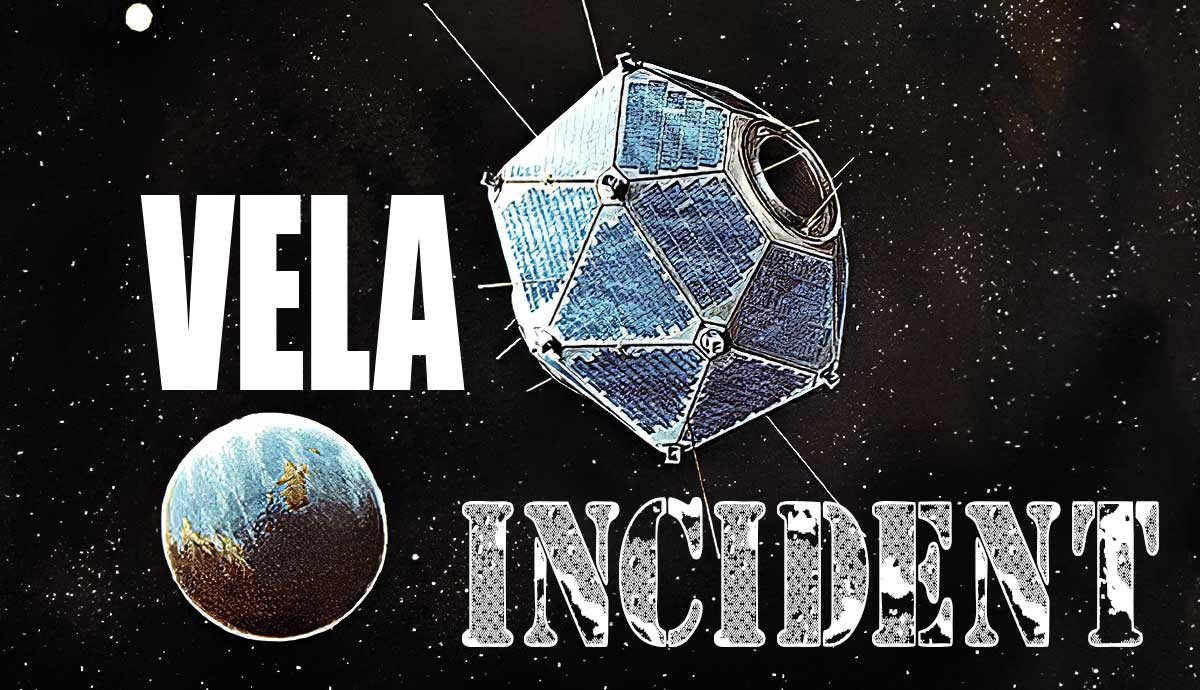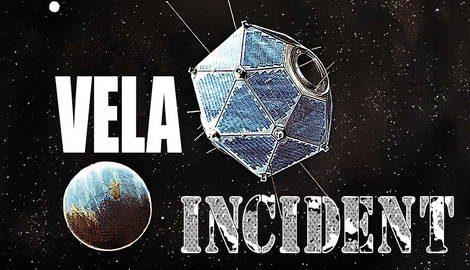
During the Cold War, the issue of nuclear weapons was controversial, as it is today. Even testing nuclear weapons under improper conditions could be considered an attack or violation of the handling of arms by a country. On September 22, 1979, a double flash was detected by United States Vela satellite 6911, which the White House semi-officially wrote off as a natural event. There is still speculation and controversy surrounding the Vela incident today as experts try to surmise what it was and why it happened.
The Context of the Vela Incident

In 1979, Jimmy Carter was President of the United States and was fully embroiled in the Cold War with the Soviet Union. Suspicions abounded between both powers, as both were armed with nuclear weapons that could instantly destroy either country.
Part of this fear had been mitigated in 1963 when, after the Cuban Missile Crisis brought the United States and the Soviet Union to the brink of nuclear war, a treaty was signed limiting the scope of nuclear testing allowed by the signatories.
The Partial Test Ban Treaty (PTBT), officially called the Treaty Banning Nuclear Weapon Tests in the Atmosphere, in Outer Space, and Under Water, prohibited the testing of nuclear weapons in any case except for those conducted underground.
Initially, the limiting of nuclear arms testing could not be agreed upon. President John F. Kennedy pushed for the total banning of testing, citing the increased public anxiety surrounding the detonation of nuclear bombs, especially after the Cuban Missile Crisis, which could have created total nuclear fallout in both countries.

However, Nikita Khrushchev, the Soviet Premier, would not agree to a total nuclear testing ban, as he saw it as an avenue for United States incursion into the USSR. Eventually, a partial ban was agreed upon when Khrushchev was advised against atmospheric testing for the health of his citizens. The PTBT was signed by the United States, the United Kingdom, and the Soviet Union in Moscow on August 5, 1963. It went into effect on October 10 of the same year, and 123 other countries ratified the treaty.
While the PTBT did not slow the proliferation of the arms race, it did significantly reduce radioactive particles present in Earth’s atmosphere. There were, notably, a few accidents and violations that occurred in the time between the treaty’s ratification and the Vela incident, but none led to panic or war.
What Happened During the Vela Incident?

On September 22, 1979, the U.S. Vela 6911 satellite, designed to detect nuclear explosions, saw an optic flash from somewhere in the South Atlantic or the Indian Ocean. The first flash was brief and intense and was then followed by a longer flash.
The explosion was thought to have been one of two to three kilotons and took place, most likely, between the Crozet Islands (a small French archipelago) and Prince Edward Island, which was at that time possessed by South Africa.
At the same time, the Arecibo Observatory, also known as the National Astronomy and Ionosphere Center (NAIC), in Puerto Rico detected an anomalous wave in the ionosphere of the Earth, which moved from southeast to northwest. An event of this kind had never been reported before and supported the evidence that the Vela incident was a nuclear test.

In the following days and weeks, the United States tested ranges throughout the possible zone to try and establish what the incident was. Acoustic data was gathered from the Sound Surveillance System (SOSUS) and the Missile Impact Locating System (MILS), both of which were designed to help the United States detect Soviet aggression, the former relating to submarines and the latter to missile nose cone impact locations.
The United States Air Force also sampled atmospheric conditions for over a month in an attempt to find fallout from a nuclear test. Both tests were unable to conclusively point to evidence for a nuclear explosion, and the flash remained a mystery for the time being.
The Official Stance on the Vela Incident

The tests carried out by the United States in the weeks following the incident had varying degrees of evidence for a nuclear test. The acoustic data collected from the region indicated no evidence of a nuclear explosion, while the atmospheric evidence said otherwise.
The US Air Force, in an attempt to conduct atmospheric tests, posited that due to wind patterns, radiation from a test in the Southern Atlantic could have ended up in Southwestern Australia. The tests conducted in the states of Victoria and Tasmania found low levels of iodine-131 in sheep there, but these results did not carry over to the sheep in New Zealand, which would have been the logical conclusion if the fallout continued with the proposed wind patterns.
The event was made public, and the Department of Defense confusingly declared that the incident was either the result of natural phenomena or a bomb blast but that they weren’t sure. While initially, classified data supported the idea that the United States National Security Council believed the incident to have been a low-yield nuclear blast, the report was revised later that year, and the NSC’s stance was officially reported as “inconclusive.”

While the cause officially remained inconclusive, President Carter gathered a panel of high-level scientific experts chaired by Massachusetts Institute of Technology (MIT) professor Dr. Jack Ruina. The panel was politically critical to Carter, who was campaigning on the nonproliferation of nuclear arms in the 1980 election.
Despite evidence to the contrary, the panel found that the incident was “probably not” the result of a nuclear explosion, as the light signature deviated significantly from that of an established nuclear test, and there was a considerable lack of nuclear fallout.
The Ruina panel concluded that the incident was likely the result of a micro meteoric impact with the specific Vela satellite 6911, as none of the other Vela satellites had detected anything. This became the semi-official stance of the White House, though other factions of the government, as well as many other scientists, believe that the incident was not researched properly.
Changes in Opinion

Though the White House never released an official public statement on the incident, its semi-official position stood behind a wall of classified studies. The Ruina panel only agreed to listen to any dissenting opinions so that they could “more safely ignore them.”
In the following years, however, bits and pieces of studies became declassified, showing the governmental turmoil brewing after the Vela incident. In their now declassified test, the CIA reported that they “assessed the probability of a nuclear test as 90% plus.”
Similarly, the Naval Research Laboratory conducted its own study, using its global hydroacoustic sensors, that appeared to corroborate the findings of the CIA, even going so far as to pinpoint a possible area of detonation.
The Ruina report came under critical scrutiny when two scientists, Lars-Erik De Geer from the Swedish Defence Force Institute and Christopher M. Wright of the Australian Defence Force Academy, reviewed the available evidence and came to the conclusion that the Vela incident was more than likely a low-yield nuclear test that the United States ignored in favor of not dealing with treaty breaches and diplomacy issues.

De Geer and Wright concluded that the argument for the Vela incident being a nuclear explosion rested on three facets: the original optical signal, the iodine-131 evidence, and the hydroacoustic signal. Each one of these facets, the scientists argued, was evidence for a low-yield nuclear explosion, but the Ruina panel would not give credit to the evidence when its report had already been published.
Changes in opinion surrounding the Vela incident abounded in the years following it. However, with so many documents from the incident still classified, the studies that are needed to produce more evidence are unavailable to the public, and even those who have studied the issue for four decades are not able to come to a substantial conclusion.
Who Could Have Been Responsible for the Vela Incident?

According to all of the reports on the Vela incident that have thus far been made public, the leading theory is that the test was a result of an Israeli-South African collaboration. Several accounts of hearsay have been presented throughout the years, including President Carter’s supposed interest in the Israeli nuclear program and the Israeli government’s alleged silencing of potentially whistleblowing journalists.
In addition to this, there has been talk of Israeli collaboration with the scientists at MIT. Several Israeli scientists worked with Jack Ruina, the White House panel’s head, who was also the Vice President of Research at MIT. Ruina also supposedly talked about the Vela incident as a probable nuclear test years later.
President Carter himself recorded in a 1980 diary entry that Israel was most likely the culprit for the test with South African logistical assistance, but this cannot and likely will not ever be proven. The Israeli government is notoriously tight-lipped about its nuclear program, and South Africa’s program was dissolved over 30 years ago.
While either country, or both together, could have been responsible for the Vela incident, without nuclear transparency and declassification of documents, it seems that the controversy will remain.
The Consensus of Today on the Vela Incident

Today’s consensus of the Vela incident is that there still isn’t a consensus. President Carter, in his White House Diary, published in 2010, admitted that even though he did not fully believe that the incident was not of nuclear origin, for diplomacy’s sake and the chance of reelection, he accepted the Ruina panel’s findings.
Government officials still sharply disagree with one another on the issue, but most who were questioned in the Woodrow Wilson Center’s Critical Oral History Conference of late 2019 agree that it was likely a nuclear test. Only those who sat on the Ruina panel refused to give any opinion that deviated from the panel’s findings but also insinuated that an addendum to the panel’s findings, including its opinion on the Naval Research Laboratory’s 300-page report on the incident, would shed light on their position.

Unfortunately, though the Critical Oral History Conference did shed light on new information and opinions on the Vela incident, its main takeaway is that we still don’t know enough to determine almost anything about the incident. The public will never have answers unless, as many of the officials alluded to during the conference, many more reports and studies are declassified by the United States government.
The public would also receive answers if the Israeli government were to shed more light on its nuclear program. This is unlikely, as the nation has kept its nuclear developments under the veil of secrecy since the program’s inception.
We may never know what happened on September 22, 1979, but the Vela incident does provide a fascinating example of internal governmental debates. It is also an example of the necessity of declassification in solving long-misunderstood mysteries and that governments have always, and probably will always, operate behind a wall of secrecy.









